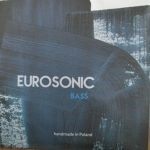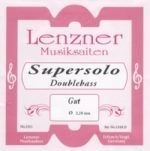Strings: Choices for Bluegrass Bassists
Choosing a string set for bluegrass playing may be a little confusing. However, we find that most players favor an "old school" sound that is usually associated with gut strings; that blunt attack and reduced sustain really emphasizes the percussive nature of bluegrass bass playing, giving us that great "thump thump" kind of vibe. With that in mind, here is a short list of selections that you might consider if you're looking for your next set of "Bluegrass Strings." These aren't the only options, mind you, but they are popular choices made by the many bluegrass-playin' bassists we talk to on a weekly basis!
You can read the short descriptions here, and jump to the set of your choice directly from this page. You can also learn more about a specific set you're interested in by clicking its link in the "related items" section, below - this may also provide other options, like different gauges or solo-tuning sets, five-string or extended E-string options, and more.
The Choices:
 LaBella Supernils
LaBella Supernils
These strings have a big and fat, boomy sound, which can be a bluegrasser's delight. They're not my personal favorite; the unusual construction gives the high strings an abrasive, almost "round-wound" feel. You should know that they can't really be bowed, and they aren't nice and smooth to fingers, either. Also, I find the lower strings deliver more boom than precise definition. However, for decades they have been very popular - both for their less than definite pitch, as well as their low price!
 D'Addario Helicore Orchestra or Helicore Hybrid
D'Addario Helicore Orchestra or Helicore Hybrid
The Orchestra strings from D'Addario's Helicore line are designed to be very bowable, as well as to have lessened sustain, since orchestral players are not looking for the same level of sustain that a jazz pizzicato performer would want. This works out well for the bluegrass bassist, providing a dark "thump" without the trebly whine that some steel strings can be guilty of - and they've got great power, while their level of definition suits the style rather well. If you prefer a little more definition, though, the Hybrid variation of the Helicore lineup is also very popular with bassists needing a more "middle of the road" sound. And either way, they're quite affordable!
 Eurosonic White Tape Wound
Eurosonic White Tape Wound
These strings are an alternative to more costly and maintenance-intensive gut strings; they have developed a cult-like following with many rockabilly and bluegrass musicians. They are made of silk and steel cores, wrapped with other metal windings and covered with a specially shaped and colorless polymer, giving Eurosonics a unique, almost milky/translucent look. Very playable, very durable, they just get "that" sound. They come in Medium, Light, and Ultra-light tensions - the Light is, by far, the most popular. The Mediums are best if you play hard and without amplification in the middle of a field somewhere - you'll be able to coax more sound out of the beast that way - but they are a bit more strenuous to play.
 Innovation Super Silver
Innovation Super Silver
These cool strings are often used for Rockabilly and Bluegrass - they're a synthetic alternative to true gut strings. They have a round tone with a blunter attack and quick decay, giving a close approximation of the gut tone - providing that 'old-school' flavor. As synthetics, they may not quite be as warm and organic sounding as the real thing - but they're far more affordable and don't have the maintenance requirements of real gut. You'll also likely find that the Super Silver Strings don't have the same "bounce" as gut, and they do have somewhat higher tension than plain guts. If you want something a little lighter, the Silver Slap set from Innovation (and the nearly identical Golden Slaps) are a lighter version of this same essential construction.
 Pirastro Obligato
Pirastro Obligato
These strings have been popular for a long time, and for good reason. They have a solid synthetic core with a very thin and smooth metal wrap. They were designed to emulate gut strings, so their attack is "old school" with a more blunt and thicker, warmer hit, with a little less sustain than more modern jazz strings. Their very smooth surface is kind to the fingers and they are a dream to bow. They even have a bit of "roll" (a lateral "twist" as you pluck) so they even react a bit like real gut strings. If you want your sound to be "traditional" for bluegrass, or other styles that call for that sound, you will probably enjoy the Obligatos.
 Lenzner Gut Set
Lenzner Gut Set
Okay, almost all the strings mentioned above compare themselves to gut. Here's the real thing, if you're looking to take the plunge! For some, there is no substitute for the soft feel and organic sweetness of true gut strings. The lowest strings have a nicely distinct but warm tone, which is an improvement over the guts of "yester-year." Gut strings do require a little maintenance; it is advisable to gently clip any "hairs" (hair-like little strands of gut that that develop with play). You may also want to oil them (walnut oil, most pure vegetable oils can do - and we have a kit available) for the longest life, especially if you are in a dry climate or go through dry periods. But if you want the authentic sound of vintage, all-natural bluegrass bass, you'll want to consider these. I prefer the wound A/E set which has metal windings to achieve the mass necessary for the lower notes without the larger diameter - the plain gut (unwound) E is quite thick and "flubby" unless you're a slap player.
The suggestions above are just that - suggestions. In over 20 years of helping bassists achieve their sound, we've definitely found that there are no "one size fits all" solutions for every bassist. If you are seeking to update/upgrade your tone, and you're getting overwhelmed with the choices, give us a call or send us an email. We're bassists, and we're here for you!
